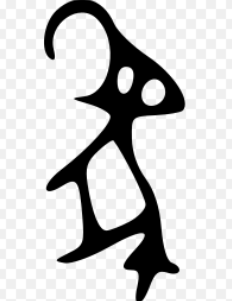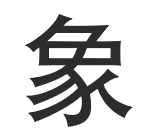The form of the elephant
Where did the character 象 (zō), or “elephant”, come from? Hint: here’s the oracle bone script version.
Get it? It’s a picture of an elephant. That’s right. This is a pure “pictogram” or “pictograph” type character; such characters make up about 5% of the total. You could also call it a “hieroglyph”.
Why would the Chinese have a character for elephants? Well, it appears that wild elephants did in fact roam China thousands of years ago; otherwise they would hardly have come up with a pictograph for them. The frequent appearance of elephant characters on the oracle bones is attributed to the fact that the oracles were praying for the success of the Shang dynasty kings on elephant hunting trips.
Elephants were prized for their tusks, of course, but were also tamed and used as beasts of burden. The character 為 (tame) is said to depict a man directing an elephant with his hand. The hand is more visible at the top in the old form of this character, 爲. Elephants in China eventually went extinct as the region cooled two thousand years ago.
Although there were obviously no elephants in Japan, this character was brought over in the first wave of imports around the sixth century, with the pronunciation zō. This is the so-called go-on (呉音) reading.
Pictographs like these are called 象形文字 (shōkei-moji). Wait, what? Is that the character for elephant we have just been discussing, right there in the word for pictograph? In other words, they’re saying “elephant” is an “elephant-shaped” character?
Indeed. This is the other meaning of the character 象, read shō. That’s the so-called kan-on (漢音) reading, typical of characters brought over in the next wave several hundred years later. Kids in Japanese schools learn both the zō and shō readings when they encounter this character in fourth grade.
You almost certainly see this character every day in compounds like 抽象 (chūshō, abstract), 象徴 (shōchō, symbol), 対象 (taishō, target), 現象 (genshō, phenomena), and 印象 (inshō, impression). Translated literally, we would get “extracting elephants”, “signs of elephants”, “aiming at elephants”, “real elephants”, and “stamping elephants”. But seriously, you may never have stopped to think about the underlying meaning of the character in this sense.
Dictionaries typically give translations such as “form”, “shape”, “likeness”, “appearance”, “trace”, “outline”, “figure”, “image”, “depiction”, “representation”, or “pattern”; alternatives might be something like “essence” or “defining characteristic”. 抽象 is to extract the underlying shape; 象徴 is to represent or signify a form; 現象 is for the form to appear in reality, so “phenomena”; and 印象 is the pattern or image impressing itself on your mind. By the way, it seems likely that at least 象徴 and 抽象 were coined by the Japanese in the Meiji period as translations of useful Western concepts. But given the frequent borrowings between China and Japan in both directions it’s hard to say for sure.
The obvious question is how this single character came to have two meanings. There are rival theories here. One holds that the elephant meaning came first and then later, when Chinese lexicographers were looking around for a character for the “form” meaning, they simply grabbed an existing one with a similar pronunciation (xiàng). Another claims that the character for elephant acquired the sense of “form” or “shape” because elephants have such distinctive shapes, with their long trunks and big ears and everything. Then there is the hypothesis that after elephants died out in China there were still lots of elephant skeletons lying around which showed the “form” of the elephant.
There was never any native Japanese word for elephant that could have been the kun-yomi for this character, but there was a native reading assigned related to the “form” meaning: 象る, or katadoru, meaning “to take the form of”. In other words, we can say 「像」という字は象を象っている, or “The character for elephant is an elephantization of an elephant.”
Simplifications
The Adobe Heiti font renders this character as shown below. Apparently the the character was simplified in China down from 12 strokes to 11 by curving the vertical line through the rectangle down towards the left, continuing directly into the first stroke of the pig radical. But this does not seem to be a separate Unicode code point.



